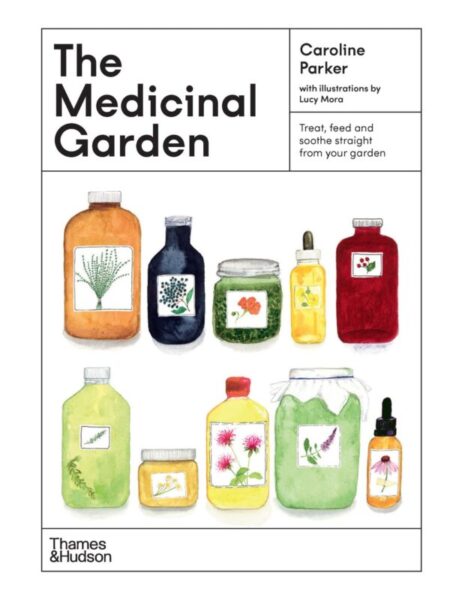The Medicinal Garden, Treat, feed and soothe straight from your garden by Caroline Parker, illustrations by Lucy Mora, Thames & Hudson 2024
This beautifully presented book is aimed at the younger gardener who is interested in organic gardening, herbalism and experimentation. The dedication reads:
For all the humble backyard and balcony growers giving growing a go.
Watercolour illustrations by Lucy Mora perfectly complement the subject matter, giving this book an olde-world, down-home feel in contrast to the many slick productions on bookshelves everywhere. It would make a lovely birthday or Christmas gift as it gives so much promise.
The Medicinal Garden addresses basic herbalism: how to grow, process and utilise many of our commonly grown herbs. From a purely gardening point of view, it is an excellent reference for beginning gardeners unsure about starting a garden or the best way to grow a particular plant. While there are many publications dealing with the horticulture of our common herbs, this book adds another dimension by targeting the home herbalist.
The book says little about the author, Caroline Parker, but a Google search tells us she runs the Cottage Herbalist at Barrys Reef in Victoria and markets a range of herbal teas. She holds a BHSc Western Herbal Medicine from Endeavour College and is a member of the Naturopaths & Herbalists Association of Australia.
Centuries ago, monks in monasteries throughout Europe were the herbalists; their medicinal gardens were well tended and treasured. Sick people living in towns and villages would head to the monastery for tinctures, compresses, poultices, potions and teas that were given out to heal or soothe ailments. The recipes were well guarded and the monks highly skilled. Some of these very old monastery gardens, especially those in Germany, have been preserved with continual replanting, regeneration and expansion. They are now popular attractions playing host to thousands of tourists annually.
In many cultures the older women in families usually had their own favourite remedies, which they passed on through the generations. My immigrant mother of Germanic heritage always had chamomile in the house for upset tummies or insomnia. As people migrated to different parts of the globe, they took their herbs and remedies with them. In my local area in New England, sheep camps are often identified by stinging nettle brought by colonists in their herbal medicine chests. Several of these introduced herbs escaped and may now be listed as weeds.
Parker focusses largely on a European herbal tradition. It would have been good to read how traditional people extracted essential oils without the wonderful kitchens we have today. Our own First Nations peoples knew the medicinal properties of every plant in their environment.
These days we have naturopaths and a well regulated herbal medicine industry which supplies us with any manner of remedies in bottles based on proven research. However, we humans often hanker for things of the past and this book offers a glimpse into the European heritage household of yesteryear. It allows the reader to experiment with herbalism, to create therapeutic products and try them out. Such products are often swapped among friends or find their way to market stalls. Parker does caution as to which species can cause allergic reactions or which species should be avoided by people with certain conditions.
She tells us:
Gardening is good for us. Gardening reduces stress, lowers anxiety, decreases mental fatigue and boosts mood.
I would have to agree. Modern life can be quite stressful as people manage challenging jobs, raising families, paying a mortgage and so on. Having even a small garden allows one to ‘switch off’, to enjoy the fruits of one’s labour and enter the peaceful slow world of nature.
The Medicinal Garden describes 48 of the more common herbs, many of which, such as parsley, are widely grown in most gardens. Sadly there are no Australian native herbs listed. Descriptions are arranged alphabetically according to their botanical names but are headed by the common name. A chart at the back of the book offers a handy summary of each herb. I would have liked to see a list of references for the medicinal claims that are made throughout. This would have allowed the reader to explore the topic further. The author does warn against using this book to replace professional medical advice. It’s also important to know that the healthful components in these plants are often miniscule. Commercial products have high concentrations of ingredients in order to achieve a beneficial effect on the body. The odd cup of herbal tea might not be very effective in curing that cold.
As well as teaching the reader how to grow and process these 48 herbs, the author offers a range of interesting recipes to accompany many of them. Some are complex and would take time to prepare, requiring specialised equipment but the instructions are quite easy to follow. It’s all a matter of experimentation and the enthusiasm to have a try.
Chapters devoted to horticulture in this book are highly practical. I particularly liked ‘Growing a potted tea garden’ where Parker lists a range of plants that can be grown together in a special garden and then the leaves harvested for making tea. She suggests this would make a wonderful children’s garden. Last but not least, the book has an excellent index − a must for every publication of this kind.


